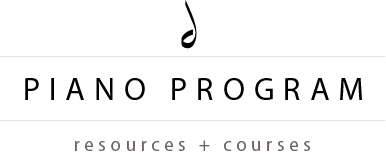Improvising using a chord chart – did you know that classical musicians, jazz musicians, church musicians, and music educators all use the skills of reading from a chord chart? We can trace chord chart reading all the way back to the baroque period of music (1600-1750), when composers such as J.S. Bach and Henry Purcell wrote a bass line with numbers and symbols above it for the keyboard player. This was a guide for the harpsichordist (remember, this was before the piano was invented) to improvise based on a chord structure given by the composer. Improvisation was a big part of the baroque period, and when we perform these compositions today, the harpsichord (or piano) player still performes an improvised part based on the figured bass notation.
Here’s an example of what the keyboard player would use to construct chords and improvise from during the Baroque period. The numbers and symbols tell the performer what chord to play, and in what inversion.
Improvisation was a skill widely used during the baroque period. However, unfortunately many classically trained musicians today have not been taught the skill of improvisation and chord chart reading. Most musicians will refer to themselves as either someone who can read music fluently (i.e. play with printed music in front of them) or play ‘by ear’. Often when we think of chord charts today, we associate that skill with jazz musicians.
Life is a lot like jazz… it’s best when you improvise.
-George Gershwin
Chord chart reading is absolutely a fundamental skill for jazz pianists, and most jazz pianists do receive training in understanding music through chord structure. When I was in grad school, a fellow student who was studying classical piano with the same teacher I was, would take his Chopin and Debussy score and write in chord symbols above every measure. To him, understanding the music through the chord structure made more sense then reading each individual note on the printed page.
But reading a chord chart is a skill not only limited to jazz musicians today! As I mentioned before, chord chart reading is widely used in church music today, and many music educators play for their classroom using a melody and chord chart. Playing using a chord chart gives all musicians freedom to express themselves and freedom to play a melody with chords. It doesn’t have to be a complicated process. When I teach chord reading to my students, I start with the tonic and dominant chords (I and V) and expand from there. What is I and V? These are two of the primary chords in a major key. If you are in C Major, I is C and V is G. If you are in G Major, I is G and V is D. If you are in F Major, I is F and V is C. After learning these two chords, I add the subdominant (IV) chord to my students harmonization exercises.
So how can you start learning how to read a chord chart? Start with a simple melody that can be harmonized with the I, IV and V chords. Play the melody and add the chords in your left hand. Some easy melodies to start with include:
Joy to the World; Simple Gifts; Twinkle Twinkle Little Star; Heart and Soul; Amazing Grace; Silent Night; Ode to Joy; Happy Birthday; etc…….
When learning how to read from a chord chart, the biggest hurdle is fear. No matter how confident we are a musicians, how many times have we backed away from the piano when someone has asked us to play something ‘just for fun’ and we have no music in front of us? How many of us have been given a chord chart to play for a choir rehearsal or a school event and just didn’t know what to do with it? How many of us are piano teachers who had a teenage student bring in the chord chart to a current pop hit and we didn’t know how to teach them? Indeed, we are dependent on the printed page as musicians; that is how we were taught. But let’s start the shift toward reading + understanding chord charts. Playing from a chord chart will make us more confident musicians, give us the skills required to teach our own students pop tunes, increase our improvisation skills, and really just make playing the piano a lot more fun. If you need a little help, my chord mini-course will give you a start in learning how to do this.
Happy chord reading!

